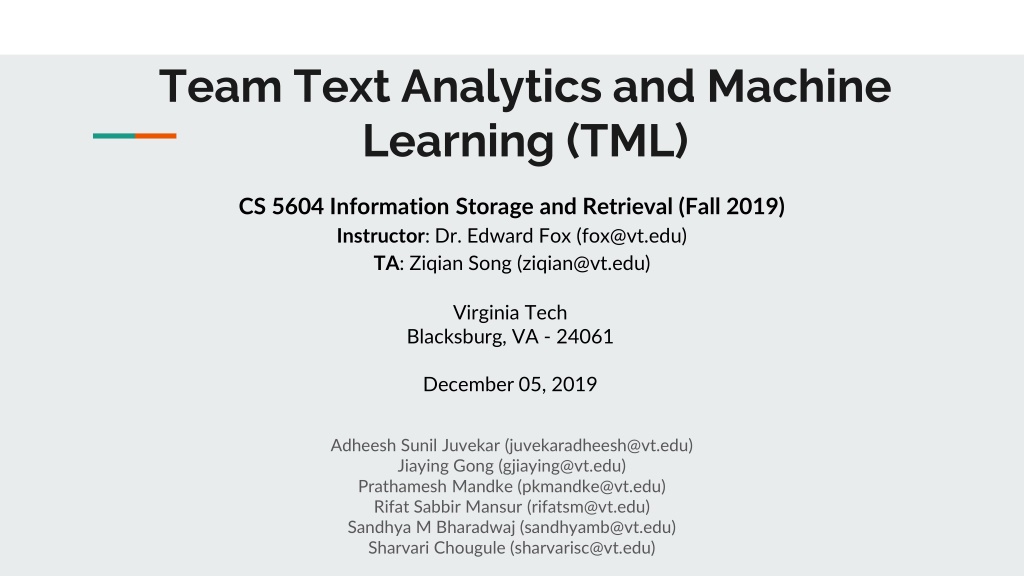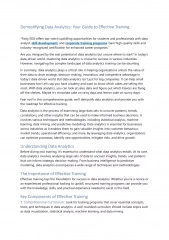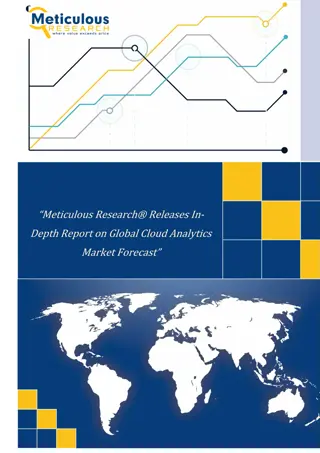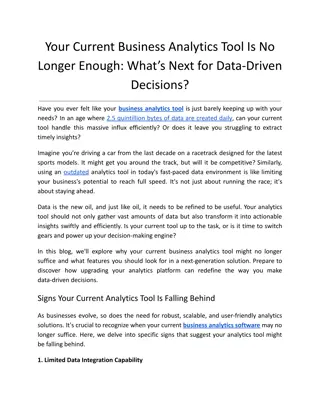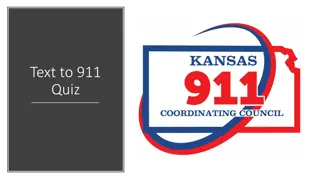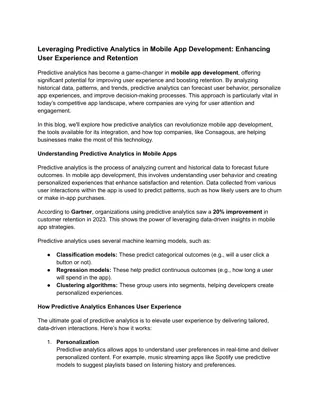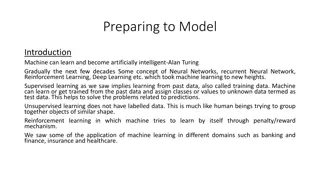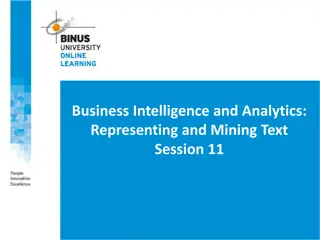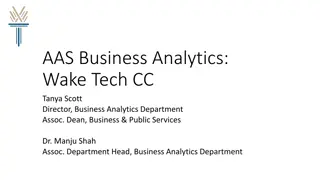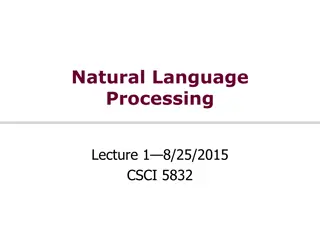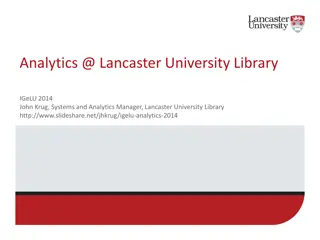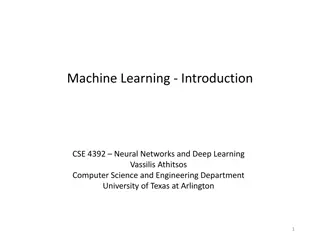Text Analytics and Machine Learning System Overview
The course covers a range of topics including clustering, text summarization, named entity recognition, sentiment analysis, and recommender systems. The system architecture involves Kibana logs, user recommendations, storage, preprocessing, and various modules for processing text data. The clustering workflow focuses on Elastic Search, preprocessing, vectorization, and utilizing Doc2Vec for clustering. Preprocessing involves cleansing, tokenization, stemming, and removal of stopwords. Challenges in document clustering include uncleaned documents leading to noisy TF-IDF vectors and sparse representations affecting results with clustering algorithms.
Download Presentation

Please find below an Image/Link to download the presentation.
The content on the website is provided AS IS for your information and personal use only. It may not be sold, licensed, or shared on other websites without obtaining consent from the author.If you encounter any issues during the download, it is possible that the publisher has removed the file from their server.
You are allowed to download the files provided on this website for personal or commercial use, subject to the condition that they are used lawfully. All files are the property of their respective owners.
The content on the website is provided AS IS for your information and personal use only. It may not be sold, licensed, or shared on other websites without obtaining consent from the author.
E N D
Presentation Transcript
Team Text Analytics and Machine Learning (TML) CS 5604 Information Storage and Retrieval (Fall 2019) Instructor: Dr. Edward Fox (fox@vt.edu) TA: Ziqian Song (ziqian@vt.edu) Virginia Tech Blacksburg, VA - 24061 December 05, 2019 Adheesh Sunil Juvekar (juvekaradheesh@vt.edu) Jiaying Gong (gjiaying@vt.edu) Prathamesh Mandke (pkmandke@vt.edu) Rifat Sabbir Mansur (rifatsm@vt.edu) Sandhya M Bharadwaj (sandhyamb@vt.edu) Sharvari Chougule (sharvarisc@vt.edu)
Outline 1. System Overview 2. Clustering 3. Text Summarization 4. Named Entity Recognition 5. Sentiment Analysis 6. Recommender Systems
System Architecture Kibana logs FEK User ELS Recommender System Clustering ETD Storage Text Summarization Ingest ETD INT Preprocess ETD Tobacco Files Storage Named-Entity Recognition CME Ingest Tobacco docs Preprocess Tobacco Documents CEPH Sentiment Analysis CMT TML
System Diagram Search Results: Result list prioritized by Recommender Systems 1. Document Title keywords: person, location, date, etc. Keywords received by Name Entity Recognition (NER) more like this sentiment Summary of the Document in 2 lines Sentiment of the document 2. Document Title Similar documents suggested by Clustering keywords: person, location, date, etc. more like this sentiment Summary of the Document in 2 lines Showing a 2 line summary using Text Summarization
Clustering Workflow - A birds eye-view! Elastic Search ETDs Cleaning & Pre- processing Vectorization TFIDF, Doc2Vec Clustering Frontend TSRs* Containerize *TSRs: Tobacco Settlement Records Doc2Vec: Le, Quoc, and Tomas Mikolov. "Distributed representations of sentences and documents." International conference on machine learning. 2014.
Pre-Processing - Step 1: Cleansing - Remove invalid UTF-8 characters - Remove punctuation and convert all characters/letters to lowercase - Step 2: Tokenization - Punkt Sentence Tokenizer - Treebank Word Tokenizer Step 3: Stemming - Porter Stemmer We also removed common English stopwords from the tokens - NLTK: https://www.nltk.org/api/nltk.chunk.html
Cluster # # of Docume nts Clustering TSRs with TF-IDF vectors 1 94 - Issues - - Possible causes - Uncleaned/raw documents containing invalid characters -> leading to noisy TF- IDF vectors. - Highly sparse TF-IDF representations with only ~1% values in a vector being non-zero. Result - Unable to get good results with either K- Means or Agglomerative Clustering. Imbalanced cluster allocation. Results not very interpretable. 2 107 3 4806 - 4 283 5 283 6 320 7 340 - 8 123 9 529 10 259
Doc2Vec [1] - From relative frequency counts to distributed representations that capture semantics. Specifics - 128-d document vectors for a total of 30961 ETDs. - Abstracts used to generate the document vectors. - Model trained for 15 epochs in a distributed memory setting using 5 parallel threads for data fetching on the ECE Guacamole servers. Why 128-d vectors? - Neither too big, nor to small! - Conducive to GPU implementations of downstream tasks that can use these document vectors. - Enough to capture information/semantics from the abstracts, entire documents will require higher dimensional vectors. - - [1] Doc2Vec: Le, Quoc, and Tomas Mikolov. "Distributed representations of sentences and documents." International conference on machine learning. 2014. (Image source)
Outline of Clustering Experiments 1. K-Means Clustering 2. Hierarchical - Agglomerative Clustering 3. DBSCAN 4. BIRCH Summary of Data Corpora
A word about metrics - - Hard to evaluate clustering algorithms when true labels are not available. We use the following metrics. The Calinski-Harabasz Index (CH score) - The index is the ratio of the sum of between-clusters dispersion and of inter-cluster dispersion for all clusters. - Intuitively, the score is higher when clusters are dense and well separated, which relates to a standard concept of a cluster. Silhouette Coefficient - The score is bounded between -1 for incorrect clustering and +1 for highly dense clustering. Davies-Bouldin Index - This index signifies the average similarity between clusters, where the similarity is a measure that compares the distance between clusters with the size of the clusters themselves. - Values close to zero indicate a better partitioning. - - Much of the content of this slide is borrowed from: https://scikit-learn.org/stable/modules/clustering.html Last Accessed: 12/05/2019
K-Means Clustering - Meta - Algorithm: EM based K-Means full algorithm. [1] - Cluster Centroids initialized with k- means++. [2] - Trained with 5 different random initializations and chosen best of 5. Average documents per cluster = 46.28 - 10 parallel threads used for data fetching. [1] Lloyd, Stuart P. "Least squares quantization in PCM." Information Theory, IEEE Transactions on 28.2 (1982): 129-137. [2] Arthur, David, and Sergei Vassilvitskii. "k-means++: The advantages of careful seeding." Proceedings of the eighteenth annual ACM-SIAM symposium on Discrete algorithms. Society for Industrial and Applied Mathematics, 2007.
Agglomerative Clustering - Meta - Dendrogram based Hierarchical Agglomerative clustering. [1] - Ward based linkage with a Euclidean distance measure. - Constructed dendrogram to obtain 500 clusters. Average documents per cluster = 46.28 [1] Rokach, Lior, and Oded Maimon. "Clustering methods." Data mining and knowledge discovery handbook. Springer US, 2005. 321-352.
BIRCH [1] - Meta - Threshold: 0.5 -> Setting this value to be very low promotes splitting of clusters. [2] - Branching Factor: 50 -> max subclusters in a node. Additional nodes are spawned when this number is exceeded. - Benefits Average documents per cluster = 46.28 - Suited for large scale databases. - Designed with low memory and computation footprint in mind. - Scales elegantly to increasing data-size. (Read easier to accommodate new incoming docs.) [1] Zhang, Tian, Raghu Ramakrishnan, and Miron Livny. "BIRCH: an efficient data clustering method for very large databases." ACM Sigmod Record. Vol. 25. No. 2. ACM, 1996. [2] https://scikit-learn.org/stable/modules/generated/sklearn.cluster.Birch.html
DBSCAN [1] - TL;DR - Does not work for ETDs! - All documents allocated to a single cluster. - Benefits - Designed to deal with large scale spatial databases with noise. Detects and discards noisy data (Read: helpful - for docs with OCR errors/garbage data). - Very few data specific hyper-parameters to be tuned. [1] Ester, Martin, et al. "A density-based algorithm for discovering clusters in large spatial databases with noise." Kdd. Vol. 96. No. 34. 1996.
A word about system integration - Clustering will augment the metadata in ELS to include a cluster ID field. - This will be used by FEK to have a Documents similar to this or alike button in the front- end. - Containerized API for assigning cluster ID to new documents.
Text Summarization Outline for text summarization Pre-processed the data for the file with too small size or too large size. Built a new model for text summarization based on three different models. (Feature-based model, Graph-based model, Topic-based model) Provided real summaries based on the above model for tobacco 1 million dataset. Did text summarization on 20 sample dataset provided from CME team.
Why pre-processing Eliminate Noise There are some garbage characters which may influence the result for text summarization. So we eliminate these garbage characters. (\r, \n, ~, ...) Improve Efficiency For text file which includes less than 4 sentences, we don t do any summarization and just copy the original file as the summary. For text file which is larger than 1Mb, we cut the whole file and do summarization separately. Otherwise, it might cause memory allocation errors.
Three Different Models Feature-based Model The feature-based model will extract the features of the sentence, then a summary will be provided based on the evaluated importance. We use Luhn s algorithm which is based on TF-IDF and assigns high weights to the sentence near the beginning of the documents.
Three Different Models Graph-based Model The graph-based model makes the graph from the document, then summarizes it by considering the relation between the nodes. We use TextRank, an unsupervised text summarization technique, to do summarization.
Three Different Models Topic-based Model The topic-based model calculates the topic of the document and evaluates each sentence by the included topics. We use Latent Semantic Analysis, which can extract hidden semantic structures of words and sentences to detect topics.
Example Feature-based Model Graph-based Model Topic-based Model Shook, Hardy and Bacon The industry now has That proposal includes the We understand that there During the interim Dr. The facilities proposed at Clinical affiliations and facilities Construction and renovation funds In our best judgement Should the decision be Shook, Hardy and Bacon We had hoped that Although no decision was The industry now has That proposal includes the We estimate that such During the interim Dr. In our best judgement In closing, let me The proposal before you During the interim Dr The industry now has Clinical affiliations and facilities Two methods of financing The facilities proposed at The proposal before you That proposal includes the We had hoped that the In our best judgement In closing, let me
New Model (Old Version) Number in red is the parameter which can be easily changed.
Example Feature-based Model Graph-based Model Topic-based Model Breed Sacramento Bee: J What the really issue And what we're looking Dr. ERICKSON: What the The House is considering Sharp was one of After a burst of Philip Morris USA had As often occurs with Plan would force small Plan would force small It "would grant FDA So the current effort In exchange for the The tobacco buyout measure As often occurs with But Ballin, now a The most appealing aspect The thinking being that Among the key obstacles David; Fisher, Scott; Gimbel He says regulation of Relatively quiet until now Burr's proposal certainly would Staff Photos by John Document RNOB000020031018 Document XSN W000020031018 Philip Morris USA had While Gregg and Kennedy Most lawmakers agree it
New Model Number in red is the parameter which can be easily changed.
Named-Entity Recognition (NER) NER is about locating and classifying named entities in texts in order to recognize places, people, dates, values, organizations, etc. 1. 2. NLTK NE_Chunk [2] 3. spaCy [3] Explored different NER packages : Stanford NER [1] 4. Blackstone [4] 5. scispaCy [5] 6. Graphbrain [6] References: [1] Stanford Named Entity Recognition (NER) and Information Extraction (IE) [2] nltk.chunk package, NLTK 3.4.5 documentation https://www.nltk.org/api/nltk.chunk.html [3] spaCy: Industrial-Strength Natural Language Processing [4] Blackstone: Model for NLP on unstructured legal text https://spacy.io/universe/project/blackstone [5] scispaCy: Models for scientific/biomedical documents https://spacy.io/universe/project/scispacy https://nlp.stanford.edu/ner/ https://spacy.io/
Named-Entity Recognition (NER) NER is about locating and classifying named entities in texts in order to recognize places, people, dates, values, organizations, etc. 1. 2. NLTK NE_Chunk [2] 3. spaCy [3] Explored different NER packages : Stanford NER [1] 4. Blackstone [4] 5. scispaCy [5] 6. Graphbrain [6] References: [1] Stanford Named Entity Recognition (NER) and Information Extraction (IE) [2] nltk.chunk package, NLTK 3.4.5 documentation https://www.nltk.org/api/nltk.chunk.html [3] spaCy: Industrial-Strength Natural Language Processing [4] Blackstone: Model for NLP on unstructured legal text https://spacy.io/universe/project/blackstone [5] scispaCy: Models for scientific/biomedical documents https://spacy.io/universe/project/scispacy https://nlp.stanford.edu/ner/ https://spacy.io/
Named-Entity Recognition (NER) spaCy provided the best results spaCy is used for Named-Entity Recognition on the entire Tobacco dataset.
spaCy Example Original Sentence: The witness, senior vice-president and controller at R. J. Reynolds Tobacco Holding Inc., was deposed by the plaintiffs. He described the financial status of the holding company and its economic activities. He indicated that industry changes, corporate changes, market changes, structural changes, and some legal developments have all had an adverse effect on the profitability of the company. The witness also noted that advertising and promotion restrictions placed on them in 1998 by the Master Settlement Agreement had caused a drop in sales volume. He said that punitive damage awards would have a devastating effect on the company, although he declined to say whether bankruptcy was being considered. Extracted Entities Type: ORG, Value: R. J. Reynolds Tobacco Holding Inc. Type: DATE, Value: 1998 Type: LAW, Value: the Master Settlement Agreement
spaCy Example Original Sentence: The witness, senior vice-president and controller at R. J. Reynolds Tobacco Holding Inc., was deposed by the plaintiffs. He described the financial status of the holding company and its economic activities. He indicated that industry changes, corporate changes, market changes, structural changes, and some legal developments have all had an adverse effect on the profitability of the company. The witness also noted that advertising and promotion restrictions placed on them in 1998 by the Master Settlement Agreement had caused a drop in sales volume. He said that punitive damage awards would have a devastating effect on the company, although he declined to say whether bankruptcy was being considered. Extracted Entities Type: ORG, Value: R. J. Reynolds Tobacco Holding Inc. Type: DATE, Value: 1998 Type: LAW, Value: the Master Settlement Agreement
spaCy Example Original Sentence: The witness, Director of Marketing Research at Philip Morris, was deposed by the plaintiffs. He reviewed his previous depositions and trail testimony, as well as the contract work that he has done for Philip Morris. He explained that the contract work consisted of showing advertising or packaging and obtaining information on consumer reactions. He reviewed the organizational structure of the Marketing and Research department of Philip Morris. The witness listed the various companies from which Philip Morris obtained consumer information. He maintained that Philip Morris only conducted studies on people over the age of 18. He explained the importance of having highly reliable information about legal age smokers in order to accurately project future industry sales and brand sales. He described Philip Morris' use of publicly available information and studies on smoking behavior. He commented on surveys in which adults were asked about their age of smoking initiation.; Roper Extracted Entities Type: ORG, Value: Marketing Research Type: ORG, Value: Philip Morris Type: ORG, Value: Philip Morris Type: ORG, Value: the Marketing and Research Type: ORG, Value: Philip Morris Type: ORG, Value: Philip Morris Type: ORG, Value: Philip Morris Type: DATE, Value: the age of 18 Type: ORG, Value: Philip Morris' Type: PERSON, Value: Roper
spaCy Example Original Sentence: The witness, Director of Marketing Research at Philip Morris, was deposed by the plaintiffs. He reviewed his previous depositions and trail testimony, as well as the contract work that he has done for Philip Morris. He explained that the contract work consisted of showing advertising or packaging and obtaining information on consumer reactions. He reviewed the organizational structure of the Marketing and Research department of Philip Morris. The witness listed the various companies from which Philip Morris obtained consumer information. He maintained that Philip Morris only conducted studies on people over the age of 18. He explained the importance of having highly reliable information about legal age smokers in order to accurately project future industry sales and brand sales. He described Philip Morris' use of publicly available information and studies on smoking behavior. He commented on surveys in which adults were asked about their age of smoking initiation.; Roper Extracted Entities Type: ORG, Value: Marketing Research Type: ORG, Value: Philip Morris Type: ORG, Value: Philip Morris Type: ORG, Value: the Marketing and Research Type: ORG, Value: Philip Morris Type: ORG, Value: Philip Morris Type: ORG, Value: Philip Morris Type: DATE, Value: the age of 18 Type: ORG, Value: Philip Morris' Type: PERSON, Value: Roper
spaCy Models 1. en_core_web_sm 11 MB 2. en_core_web_md 91 MB 3. en_core_web_lg 789 MB 4. en_trf_bertbaseuncased_lg 387 MB en_trf_robertabase_lg 278 MB en_trf_distilbertbaseuncased_lg 233 MB en_trf_xlnetbasecased_lg (Google & Hugging Face) 5. (Facebook & Hugging Face) 6. (Hugging Face) 7. (CMU & Google Brain)
NER System Architecture Unit Testing Pre-processing + filename extraction Run NER model (spaCy) Output by filename Automated Process CEPH
NER Automation Scripts for automation of NER on tobacco dataset Automation has been performed on a sample dataset on local machine. Results of NER is stored in a text file for ingestion by ELS team. Kev value pairs of NER
Example: Document ID: jtvf0005 Attendance at PR meeting September 10, 1958; James P. Richards Robert K. He~jnann 0. D. Campbell 6ene L. Cooper W. S. Cutchins Margaret Carson H. C. Robinson Jr. Dan Provost James C. Bowling Jokm Scott Fones Rex Lardner John Jones Richard W. Darrow Carl C. Thompson Leonard S. Zatm Kenneth L. Austin D7alco'-m Jo'nnson W. T. Hoyt The Tobacco Institute, Inc, The Amer:can Tobacco Company Braun and Company, Inc. Braun and Company, Inc. Brown and Williamson Tobacco Corp. M. Carson, Inc. Liggett & Myers Tobacco Company D:cCann-Erickson, Inc. Philip Morris, Inc. Benjamin Sonnenberg Sidney J. Wain, Inc. Sidney J. Wain, Inc. Hill end Hnowlton, Inc. F.111 and Knowlton, Inc. Hill and Knowlton, Inc. Hil'_ and Knowlton, Inc. Hi1= and Kaowlton, Inc. Tobacco Industry Research Conmittee
Example: Document ID: jtvf0005 - NER results jtvf0005.txt: [('DATE', September 10, 1958), ('PERSON', James P. Richards), ('PERSON', Robert K.), ('NORP', D.), ('ORG', Campbell), ('PERSON', James C. Bowling), ('PERSON', John Jones Richard W. Darrow), ('PERSON', Carl C. Thompson), ('ORG', The Tobacco Institute), ('PERSON', Inc), ('ORG', The Amer:can Tobacco Company Braun and Company), ('PERSON', M. Carson), ('ORG', Liggett & Myers Tobacco Company D), ('ORG', cCann-Erickson), ('ORG', Philip Morris), ('PERSON', Benjamin Sonnenberg Sidney J. Wain), ('PERSON', Sidney J. Wain), ('ORG', Inc. Hill end), ('GPE', Hnowlton), ('ORG', Inc. F.111), ('GPE', Knowlton), ('ORG', Inc. Hill), ('GPE', Knowlton), ('ORG', Inc. Hil'), ('WORK_OF_ART', _ and Knowlton, Inc. Hi1=), ('GPE', Kaowlton)]
Sentiment Analysis Flair [1] Twitter Emotion Recognition [2] Empath [3] SenticNet [4] [1] Flair: Pooled Contextualized Embeddings for Named Entity Recognition, [2] Twitter Emotion Recognition, recognition [3] Empath: Understanding Topic Signals in Large-Scale Text, 2016.pdf [4] SenticNet: Emotion Recognition in Conversations, https://github.com/zalandoresearch/flair https://github.com/nikicc/twitter-emotion- https://hci.stanford.edu/publications/2016/ethan/empath-chi- https://github.com/SenticNet/conv-emotion
Sentiment Analysis Flair [1] Twitter Emotion Recognition [2] Empath [3] SenticNet [4] [1] Flair: Pooled Contextualized Embeddings for Named Entity Recognition, [2] Twitter Emotion Recognition, recognition [3] Empath: Understanding Topic Signals in Large-Scale Text, 2016.pdf [4] SenticNet: Emotion Recognition in Conversations, https://github.com/zalandoresearch/flair https://github.com/nikicc/twitter-emotion- https://hci.stanford.edu/publications/2016/ethan/empath-chi- https://github.com/SenticNet/conv-emotion
Empath: Categories Total categories: 194 Total models: 3
Empath: Lexical Categorization [('achievement', 0.0), ('affection', 0.002036659877800407), ('aggression', 0.002036659877800407), ('air_travel', 0.0), ('alcohol', 0.0), ('ancient', 0.0), ('anger', 0.0), ('animal', 0.0), ('anonymity', 0.0), ('anticipation', 0.0), ('appearance', 0.0), ('art', 0.012219959266802444), ('attractive', 0.0), ('banking', 0.0), ('beach', 0.0), ('beauty', 0.0), ('blue_collar_job', 0.0), ('body', 0.0), ('breaking', 0.0), ('business', 0.0), ('car', 0.0), ('celebration', 0.0), ('cheerfulness', 0.0), ('childish', 0.0), ('children', 0.0), ('cleaning', 0.0), ('clothing', 0.0), ('cold', 0.0), ('college', 0.006109979633401222), ('communication', 0.008146639511201629), ('competing', 0.0), ('computer', 0.006109979633401222), ('confusion', 0.0), ('contentment', 0.002036659877800407), ('cooking', 0.0), ('crime', 0.0), ('dance', 0.002036659877800407), ('death', 0.0), ('deception', 0.0), ('disappointment', 0.0), ('disgust', 0.0), ('dispute', 0.004073319755600814), ('divine', 0.0), ('domestic_work', 0.0), ('dominant_heirarchical', 0.0), ('dominant_personality', 0.0), ('driving', 0.0), ('eating', 0.0), ('economics', 0.002036659877800407), ('emotional', 0.0), ('envy', 0.0), ('exasperation', 0.0), ('exercise', 0.004073319755600814), ('exotic', 0.0), ('fabric', 0.0), ('family', 0.0), ('farming', 0.0), ('fashion', 0.0), ('fear', 0.004073319755600814), ('feminine', 0.0), ('fight', 0.006109979633401222), ('fire', 0.0), ('friends', 0.002036659877800407), ('fun', 0.0), ('furniture', 0.0), ('gain', 0.002036659877800407), ('giving', 0.0), ('government', 0.0), ('hate', 0.002036659877800407), ('healing', 0.006109979633401222), ('health', 0.0), ('hearing', 0.0), ('help', 0.004073319755600814), ('heroic', 0.004073319755600814), ('hiking', 0.0), ('hipster', 0.006109979633401222), ('home', 0.0), ('horror', 0.0), ('hygiene', 0.0), ('independence', 0.002036659877800407), ('injury', 0.0), ('internet', 0.006109979633401222), ('irritability', 0.0), ('journalism', 0.002036659877800407), ('joy', 0.002036659877800407), ('kill', 0.0), ('law', 0.0), ('leader', 0.0), ('legend', 0.0), ('leisure', 0.0), ('liquid', 0.0), ('listen', 0.002036659877800407), ('love', 0.002036659877800407), ('lust', 0.002036659877800407), ('magic', 0.0), ('masculine', 0.0), ('medical_emergency', 0.0), ('medieval', 0.0), ('meeting', 0.018329938900203666), ('messaging', 0.0), ('military', 0.004073319755600814), ('money', 0.002036659877800407), ('monster', 0.0), ('morning', 0.0), ('movement', 0.008146639511201629), ('music', 0.002036659877800407), ('musical', 0.002036659877800407), ('negative_emotion', 0.0), ('neglect', 0.0), ('negotiate', 0.0), ('nervousness', 0.002036659877800407), ('night', 0.0), ('noise', 0.0), ('occupation', 0.0), ('ocean', 0.0), ('office', 0.0), ('optimism', 0.008146639511201629), ('order', 0.0), ('pain', 0.002036659877800407), ('party', 0.0), ('payment', 0.002036659877800407), ('pet', 0.0), ('philosophy', 0.004073319755600814), ('phone', 0.0), ('plant', 0.0), ('play', 0.0), ('politeness', 0.002036659877800407), ('politics', 0.0), ('poor', 0.0), ('positive_emotion', 0.010183299389002037), ('power', 0.004073319755600814), ('pride', 0.0), ('prison', 0.0), ('programming', 0.006109979633401222), ('rage', 0.0), ('reading', 0.008146639511201629), ('real_estate', 0.0), ('religion', 0.0), ('restaurant', 0.0), ('ridicule', 0.0), ('royalty', 0.0), ('rural', 0.0), ('sadness', 0.002036659877800407), ('sailing', 0.0), ('school', 0.014256619144602852), ('science', 0.006109979633401222), ('sexual', 0.0), ('shame', 0.002036659877800407), ('shape_and_size', 0.002036659877800407), ('ship', 0.0), ('shopping', 0.0), ('sleep', 0.0), ('smell', 0.0), ('social_media', 0.016293279022403257), ('sound', 0.0), ('speaking', 0.008146639511201629), ('sports', 0.0), ('stealing', 0.0), ('strength', 0.002036659877800407), ('suffering', 0.002036659877800407), ('superhero', 0.0), ('surprise', 0.0), ('swearing_terms', 0.0), ('swimming', 0.0), ('sympathy', 0.004073319755600814), ('technology', 0.006109979633401222), ('terrorism', 0.0), ('timidity', 0.0), ('tool', 0.0), ('torment', 0.0), ('tourism', 0.0), ('toy', 0.0), ('traveling', 0.0), ('trust', 0.002036659877800407), ('ugliness', 0.0), ('urban', 0.0), ('vacation', 0.0), ('valuable', 0.002036659877800407), ('vehicle', 0.0), ('violence', 0.0), ('war', 0.0), ('warmth', 0.0), ('water', 0.0), ('weakness', 0.0), ('wealthy', 0.004073319755600814), ('weapon', 0.0), ('weather', 0.0), ('wedding', 0.0), ('white_collar_job', 0.0), ('work', 0.0), ('worship', 0.0), ('writing', 0.002036659877800407), ('youth', 0.0), ('zest', 0.002036659877800407)]
Empath: Lexical Categorization [('meeting', 0.018329938900203666), ('social_media', 0.016293279022403257), ('school', 0.014256619144602852), ('art', 0.012219959266802444), ('positive_emotion', 0.010183299389002037), ('optimism', 0.008146639511201629), ('reading', 0.008146639511201629), ('movement', 0.008146639511201629), ('communication', 0.008146639511201629), ('speaking', 0.008146639511201629), ('computer', 0.006109979633401222), ('college', 0.006109979633401222), ('hipster', 0.006109979633401222), ('internet', 0.006109979633401222), ('healing', 0.006109979633401222), ('programming', 0.006109979633401222), ('fight', 0.006109979633401222), ('science', 0.006109979633401222), ('technology', 0.006109979633401222), ('help', 0.004073319755600814), ('dispute', 0.004073319755600814), ('wealthy', 0.004073319755600814), ('exercise', 0.004073319755600814), ('fear', 0.004073319755600814), ('heroic', 0.004073319755600814), ('military', 0.004073319755600814), ('sympathy', 0.004073319755600814), ('power', 0.004073319755600814), ('philosophy', 0.004073319755600814), ('dance', 0.002036659877800407), ('money', 0.002036659877800407), ('hate', 0.002036659877800407), ('aggression', 0.002036659877800407), ('nervousness', 0.002036659877800407), ('suffering', 0.002036659877800407), ('journalism', 0.002036659877800407), ('independence', 0.002036659877800407), ('zest', 0.002036659877800407), ('love', 0.002036659877800407), ('trust', 0.002036659877800407), ('music', 0.002036659877800407), ('politeness', 0.002036659877800407), ('listen', 0.002036659877800407), ('gain', 0.002036659877800407), ('valuable', 0.002036659877800407), ('sadness', 0.002036659877800407), ('joy', 0.002036659877800407), ('affection', 0.002036659877800407), ('lust', 0.002036659877800407), ('shame', 0.002036659877800407), ('economics', 0.002036659877800407), ('strength', 0.002036659877800407), ('shape_and_size', 0.002036659877800407), ('pain', 0.002036659877800407), ('friends', 0.002036659877800407), ('payment', 0.002036659877800407), ('contentment', 0.002036659877800407), ('writing', 0.002036659877800407), ('musical', 0.002036659877800407), ('office', 0.0), ('wedding', 0.0), ('domestic_work', 0.0), ('sleep', 0.0), ('medical_emergency', 0.0), ('cold', 0.0), ('cheerfulness', 0.0), ('occupation', 0.0), ('envy', 0.0), ('anticipation', 0.0), ('family', 0.0), ('vacation', 0.0), ('crime', 0.0), ('attractive', 0.0), ('masculine', 0.0), ('prison', 0.0), ('health', 0.0), ('pride', 0.0), ('government', 0.0), ('weakness', 0.0), ('horror', 0.0), ('swearing_terms', 0.0), ('leisure', 0.0), ('royalty', 0.0), ('tourism', 0.0), ('furniture', 0.0), ('magic', 0.0), ('beach', 0.0), ('morning', 0.0), ('banking', 0.0), ('night', 0.0), ('kill', 0.0), ('blue_collar_job', 0.0), ('ridicule', 0.0), ('play', 0.0), ('stealing', 0.0), ('real_estate', 0.0), ('home', 0.0), ('divine', 0.0), ('sexual', 0.0), ('irritability', 0.0), ('superhero', 0.0), ('business', 0.0), ('driving', 0.0), ('pet', 0.0), ('childish', 0.0), ('cooking', 0.0), ('exasperation', 0.0), ('religion', 0.0), ('surprise', 0.0), ('worship', 0.0), ('leader', 0.0), ('body', 0.0), ('noise', 0.0), ('eating', 0.0), ('medieval', 0.0), ('confusion', 0.0), ('water', 0.0), ('sports', 0.0), ('death', 0.0), ('legend', 0.0), ('celebration', 0.0), ('restaurant', 0.0), ('violence', 0.0), ('dominant_heirarchical', 0.0), ('neglect', 0.0), ('swimming', 0.0), ('exotic', 0.0), ('hiking', 0.0), ('hearing', 0.0), ('order', 0.0), ('hygiene', 0.0), ('weather', 0.0), ('anonymity', 0.0), ('ancient', 0.0), ('deception', 0.0), ('fabric', 0.0), ('air_travel', 0.0), ('dominant_personality', 0.0), ('vehicle', 0.0), ('toy', 0.0), ('farming', 0.0), ('war', 0.0), ('urban', 0.0), ('shopping', 0.0), ('disgust', 0.0), ('fire', 0.0), ('tool', 0.0), ('phone', 0.0), ('sound', 0.0), ('injury', 0.0), ('sailing', 0.0), ('rage', 0.0), ('work', 0.0), ('appearance', 0.0), ('warmth', 0.0), ('youth', 0.0), ('fun', 0.0), ('emotional', 0.0), ('traveling', 0.0), ('fashion', 0.0), ('ugliness', 0.0), ('torment', 0.0), ('anger', 0.0), ('politics', 0.0), ('ship', 0.0), ('clothing', 0.0), ('car', 0.0), ('breaking', 0.0), ('white_collar_job', 0.0), ('animal', 0.0), ('party', 0.0), ('terrorism', 0.0), ('smell', 0.0), ('disappointment', 0.0), ('poor', 0.0), ('plant', 0.0), ('beauty', 0.0), ('timidity', 0.0), ('negotiate', 0.0), ('negative_emotion', 0.0), ('cleaning', 0.0), ('messaging', 0.0), ('competing', 0.0), ('law', 0.0), ('achievement', 0.0), ('alcohol', 0.0), ('liquid', 0.0), ('feminine', 0.0), ('weapon', 0.0), ('children', 0.0), ('monster', 0.0), ('ocean', 0.0), ('giving', 0.0), ('rural', 0.0)]
Empath: Lexical Categorization [('meeting', 0.018329938900203666), ('social_media', 0.016293279022403257), ('school', 0.014256619144602852), ('art', 0.012219959266802444), ('positive_emotion', 0.010183299389002037), ('optimism', 0.008146639511201629), ('reading', 0.008146639511201629), ('movement', 0.008146639511201629), ('communication', 0.008146639511201629), ('speaking', 0.008146639511201629), ('computer', 0.006109979633401222), ('college', 0.006109979633401222), ('hipster', 0.006109979633401222), ('internet', 0.006109979633401222), ('healing', 0.006109979633401222), ('programming', 0.006109979633401222), ('fight', 0.006109979633401222), ('science', 0.006109979633401222), ('technology', 0.006109979633401222), ('help', 0.004073319755600814), ('dispute', 0.004073319755600814), ('wealthy', 0.004073319755600814), ('exercise', 0.004073319755600814), ('fear', 0.004073319755600814), ('heroic', 0.004073319755600814), ('military', 0.004073319755600814), ('sympathy', 0.004073319755600814), ('power', 0.004073319755600814), ('philosophy', 0.004073319755600814), ('dance', 0.002036659877800407), ('money', 0.002036659877800407), ('hate', 0.002036659877800407), ('aggression', 0.002036659877800407), ('nervousness', 0.002036659877800407), ('suffering', 0.002036659877800407), ('journalism', 0.002036659877800407), ('independence', 0.002036659877800407), ('zest', 0.002036659877800407), ('love', 0.002036659877800407), ('trust', 0.002036659877800407), ('music', 0.002036659877800407), ('politeness', 0.002036659877800407), ('listen', 0.002036659877800407), ('gain', 0.002036659877800407), ('valuable', 0.002036659877800407), ('sadness', 0.002036659877800407), ('joy', 0.002036659877800407), ('affection', 0.002036659877800407), ('lust', 0.002036659877800407), ('shame', 0.002036659877800407), ('economics', 0.002036659877800407), ('strength', 0.002036659877800407), ('shape_and_size', 0.002036659877800407), ('pain', 0.002036659877800407), ('friends', 0.002036659877800407), ('payment', 0.002036659877800407), ('contentment', 0.002036659877800407), ('writing', 0.002036659877800407), ('musical', 0.002036659877800407)] Total categories: 194 Total models: 3 How many categories to consider?
Basic Emotions Ekman's six basic emotions [1] Plutchik's eight basic emotions [2] Profile of Mood States (POMS) six mood states [3] References: [1] Ekman, Paul. "Basic emotions." Handbook of cognition and emotion 98.45-60 (1999): 16. [2] Plutchik, Robert. "Emotions: A general psychoevolutionary theory." Approaches to emotion 1984 (1984): 197-219. [3] Curran, Shelly L., Michael A. Andrykowski, and Jamie L. Studts. "Short form of the profile of mood states (POMS-SF): psychometric information." Psychological assessment 7.1 (1995): 80.
Six basic emotions Love Hate Joy Fear Surprise Envy
Sentiment Analysis System Architecture Unit Testing Pre-processing + filename extraction Run Sentiment Analysis (empath) Select the highest sentiments Select sentiment categories Output by filename Automated Process CEPH
Recommender System System that is capable of predicting the future preference of a set of items for a user, and recommend the top items. Implementation details : Identified a sample dataset of user logs Implemented content based and collaborative filtering dataset recommendation techniques on this sample
Why this sample dataset ? Our entire search engine was not completely integrated at that time and we wanted to show a prototype of implementation The selected dataset is based on real logs and has fields similar to our search logs SAMPLE DATASET: CI&T's Internal Communication platform (DeskDrop)[1] Contains a real sample of 12 months logs (Mar. 2016 - Feb. 2017) and 73k logged users interactions 1140 total users, 2926 documents Has fields such as Person ID, Content ID, Session ID, Timestamp, etc [1] https://www.kaggle.com/gspmoreira/articles-sharing-reading-from-cit-deskdrop
Content based recommendation Recommends items that are similar to those that a user liked in the past STEPS: Build user profile by constructing item profile for all the items the user has interacted with using TF-IDF. Get items which are similar to the user profile - Cosine Similarity between user profile and TF-IDF Matrix Sort the similar items and recommend items to the user. 1) 2) 3) Evaluation result of Content based filtering : Recall@5 = 0.4145 Recall@10 = 0.5241
Collaborative Filtering Model User-based Approach: Uses memory of previous users interactions to compute similarity based on items they have interacted with. Item-based Approach: Compute item similarities based on users that have interacted with them. Matrix Factorization: User-item matrix is compressed to low-dimensional representation in terms of latent factors. SVD (Singular value decomposition) Latent factor model is used. Evaluation Result of Collaborative Filtering Recall@5 = 33.4% Recall@10 = 46.81%
Performance comparison: Content based : Clustering Collaborative filtering : User logs
